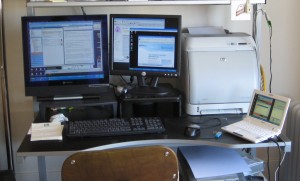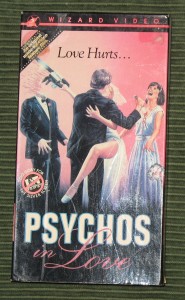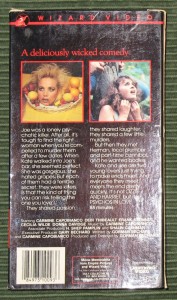Archive for July 2008
Work with Marty Nemko
I caught this radio show a few weeks ago and now I’m listening via podcast a lot. Work with Marty Nemko is a really good program.
I very much enjoyed this show:
7/6 Mary Ruwart, Libertarian presidential candidate, who argues that Libertarianism is best for American employees. To hear or download the show, click HERE
Here is a local archive. You’re very welcome to listen!
Marty asks intelligent, supportive and critical questions of his guest.
Listen to more episodes of Work with Marty Nemko here. Or via NPR podcast here.
Outlaw Trans-fats and Only Outlaws will have Trans-fats
State ban on serving trans fat first in U.S.
California became the first state to outlaw trans fat in restaurants and food facilities Friday when Gov. Arnold Schwarzenegger signed a bill banning the artery-clogging oils and shortenings.
The bill, by Assemblyman Tony Mendoza, D-Artesia (Los Angeles County), had started heated debate in the Legislature. But many Bay Area restaurant owners say they don’t use trans fats, and others say complying with the new state law will not be burdensome.
I was going to make a T-Shirt that reads “Outlaw Trans-fats and Only Outlaws will have Trans-fats”. But reading into the issue further (IE, the second paragraph of the article) it’s more of an issue of closing the barn door after the horse has left. Or to be more gentle about it, codifying a trend in law.
This reminds me very much of what Mary Ruwart, Libertarian presidential candidate said about child labor laws. On 7-6-08 she spoke on Marty Nemko’s radio show about libertarian issues. She had said that child labor laws in the US followed on the coat-tails of trends at the end of the industrial revolution. The laws didn’t stop people from hiring child-workers. The trend of children not working in factories had already taken place.
Given the choice, people would rather not send their children to work in factories. After enough wealth had been generated, it stopped happening.
She talks about child labor law starts at 44 minutes, 10 seconds.
Here is the whole radio show (30 mb, 60 minutes), Work with Marty Nemko, July 6th, 2008.
Similarly, it’s (apparently) not difficult or more expensive to make non-trans-fat oils. Individuals, restaurants and manufacturers have already made the switch.
I said it before and I’ll say it again

Harumph!
Governor William J. Le Petomane: HOLY UNDERWEAR! People murdered? Innocent women and children blown to bits? We must do something to protect our phoney-baloney jobs people. Harumph! Harumph!
All of the governor’s lackeys but one chant along with him: Harumph! Harumph!
Governor: I didn’t get a harumph out of that guy.
Another lackey: Give the governer a harumph!
Lackey: Harumph!
Governor: You watch your ass.
How to sell items on Amazon.com
If you have lots of books to get rid of, Amazon.com can be a good way to sell them. Here are some tips. I’m making this list because I just went through another round of selling stuff and want to remember it for next time.
- Find the book on Amazon via the ISBN number. It’s easy to find on the back right next to the bar code.
- Say something nice in the listing like “ships from San Francisco”. If the book is under 13 oz, you can ship it USPS first class inexpensively and legitimately mention “fast shipping”.
- Always make sure yours is the lowest price listing.
- Offering “expedited” or “international” shipping is a bother and usually not worth the money.
- Stamps.com is a bargain if you have a lot of items to ship in a month. They charge $15/month but you get to print the return address, address and postage all in one go, saving time. And you just have to copy and paste the address. Most importantly, the envelopes are then not “stamped” but “metered” and you can drop them in any USPS drop box no matter how heavy they are. USPS.com has/had a similar option on their website but it’s a pain to navigate (it’s the government, who’d have guessed!)
- Use UPS labels, 2 labels per 8.5×11″ sheet. They are free (for shipping UPS items only of course) from ups.com. I usually use the second label on the page to seal the envelope.
- Use 9×12″ manila envelopes. They are inexpensive and most books fit in them. Note that a padded mailer might cost $2.00 each while these cost $0.20 each. They also qualify as “envelopes” and not “packages” so they ship cheaper
- Use USPS “Bound Printed Matter” or “Media Mail” rate.
- Use a postal scale.
- Amazon should have a “I shipped this item” checkbox next to your sold items but they don’t. I use the change in color of a visited-link to note when I ship.
Bush or Batman
Bush or Batman is the hottest new game in town. You have to guess whether the quote you are about to hear was said by George W. Bush or Batman as played by Adam West. Sounds easy enough, doesn’t it?
“Right here I have a series of 30 quotes that were either by set by George Bush as president of the United States or Batman in the 1960s TV show.
I’m going to ask you as many as I can in one minute. your job is to attribute them properly
Bush or Batman.
And if you can get half of them right, you win…”
Bush or Batman?
local version:
Historical Electric Rates
Solar proponents claim that electric rates in California have been going up significantly faster than inflation, making solar a good deal. Here’s the data to prove it.
http://www.energy.ca.gov/electricity/weighted_avg_retail_prices.html
Utility-Wide Weighted Average Retail Electricity Prices 1980-2005
(nominal $) (cents/kWh)
Year PG&E SCE SDG&E LADWP SMUD BGP ESPs Other Municipal Utilities Historical 1980 4.76 6.09 8.43 5.61 2.53 6.72 1981 6.05 6.45 9.36 6.16 2.82 6.48 1982 6.24 7.37 11.26 6.11 3.03 7.60 1983 6.42 7.42 11.66 5.85 3.75 7.48 1984 7.86 7.64 11.80 6.08 3.92 7.79 1985 8.73 7.94 12.84 6.54 4.56 7.81 1986 8.72 8.20 11.66 6.74 5.45 7.65 1987 7.56 8.19 10.42 7.09 6.64 8.22 1988 7.85 8.51 9.82 7.57 7.35 9.05 1989 8.79 9.17 9.51 8.06 7.41 9.50 1990 9.24 9.45 9.22 8.39 8.27 9.82 1991 9.87 10.07 9.36 8.23 8.30 9.91 1992 10.42 10.36 9.47 8.62 8.21 10.34 1993 10.59 10.06 9.89 9.13 7.69 10.96 1994 10.71 10.28 9.69 9.53 7.96 11.49 1995 9.89 10.46 9.67 9.14 8.18 11.43 1996 10.20 10.22 10.36 9.12 8.14 11.36 1997 10.30 10.22 10.70 9.36 7.92 10.51 1998 9.74 10.10 10.16 9.76 7.63 10.95 1999 9.81 10.05 10.16 9.75 7.60 10.96 2000 9.82 10.12 13.72 9.79 7.61 10.97 2001 11.74 12.87 13.66 9.79 9.26 13.57 2002 12.72 12.82 14.45 9.80 9.27 12.72 2003 13.18 13.16 14.26 9.80 9.81 12.43 2004 12.72 12.18 14.55 9.66 8.60 11.88 6.19 9.34 2005 13.07 12.93 14.72 9.31 10.10 11.97 6.44 9.51
Note: Energy Commission staff estimated these prices using data from EIA, utility websites and submittals during the IEPR cycles.
Utility-Wide Prices – These include prices for residential, commercial, industrial and agricultural customer classes.
BGP – This category includes electricity rates for customers of the cities of Burbank, Glendale and Pasadena.
Other Municipal Utilities – This category includes rates for Redding Electric Utility, Silicon Valley Power, City of Anaheim, Riverside, Roseville, Modesto Irrigation District, Turlock Irrigation District, and Imperial Irrigation District.
ESPs – These rates only reflect the generation portion of the total rate. Other charges such as T&D must be added. ESPs – Energy Service Providers include Arizona Power Service (APS), Constellation New Energy (CNE), Pilot Power Group, Strategic Energy LLC, and Sempra Energy Solutions.
http://www.eia.doe.gov/cneaf/electricity/epm/table5_6_a.html
Table 5.6.A. Average Retail Price of Electricity to Ultimate Customers by End-Use Sector, by State, November 2007 and 2006 (Cents per kilowatthour)
Residential Commercial Industrial1 Transportation All Sectors California Nov-07 Nov-06 Nov-07 Nov-06 Nov-07 Nov-06 Nov-07 Nov-06 Nov-07 Nov-06 California 14.26 14.47 11.94 12.23 9.75 9.66 7.8 7.27 12.23 12.38
http://www.neo.ne.gov/statshtml/115.htm
Average Revenue per Kilowatthour by State (Lowest to Highest Rate as of November 2007) Rank State Average Electricity Rate for All Sectors (Cents per Kilowatthour) 39 Maryland 11.58 40 District of Columbia 11.99 41 Vermont 12.11 42 California 12.23 43 New Jersey 12.84 44 Alaska 13.12 45 Rhode Island 13.55 46 Maine 13.66 47 New Hampshire 13.68 48 Massachusetts 14.71 49 New York 14.90 50 Connecticut 15.77 51 Hawaii 23.67
More info http://www.energy.ca.gov/electricity/index.html#rates
Solar Power Information Resource
I gathered this information when I was trying to make a living selling residential solar systems. The job didn’t agree with me but this information is still valid. Check it out
Internal Rate of Return tutorial http://hspm.sph.sc.edu/COURSES/ECON/irr/irr.html
- ask at the public library. SF Public Library online
Solar time of Use (local copy) A paper about Electricity Rate Structures and the Economics of Solar PV: Could Mandatory Time-of-Use Rates Undermine California’s Solar Photovoltaic Subsidies? – shown to Lee by his neighbor Oren Ahoobim
Federal Information Sources
- SEIA Solar Roadmap(local) – Notably on page 7 it shows that they think solar prices will decrease slowly. No great breakthrough on the horizon.
- http://search.nrel.gov/query.html?qm=1&charset=iso-8859-1&style=eere&col=eren&qc=eren&ht=815081754&ct=776116691 lots of sub-categories of info
- http://www.eia.doe.gov/cneaf/solar.renewables/rea_issues/contents.html http://www.eia.doe.gov/cneaf/solar.renewables/rea_issues/incent.html#intro I think this talks about long term net metering contracts. IE:
Under PURPA, utilities are required to purchase electricity from QFs at the utilities’ “avoided cost.” (11) The Federal government, in formulating regulations, often delegates implementation to the States. This occurred with PURPA, as the Federal Energy Regulatory Commission (FERC) delegated the authority for the determination of avoided cost to the States. In several States including California, avoided cost purchase contracts were very favorable to non-utility generators. For example, between 1982 and 1988, Standard Offer 4 (SO4) contracts written in California allowed QFs to sell renewable energy under 15-to-30 year terms.
- Treasury and IRS Provide Guidance for energy Credits for Homeowners
- Publication 17 (last year’s individual tax code) online version, PDF
- Publication 553 “Highlights of 2005 Tax Changes” PDF Publication 553 Excerpt
- Notice 2006-26 Credit for Nonbusiness Energy Property (only covers effeciency enhancing products like insulation and good water heaters)
Additionally, the new law makes a credit available to those who add qualified solar panels, solar water heating equipment, or a fuel cell power plant to their homes in the United States. In general, a qualified fuel cell power plant converts a fuel into electricity using electrochemical means, has an electricity—only generation efficiency of more than 30 percent and generates at least 0.5 kilowatts of electricity. Taxpayers are allowed one credit equal to 30 percent of the qualified investment in a solar panel up to a maximum credit of $2,000, and another equivalent credit for investing in a solar water heating system. No part of either system can be used to heat a pool or hot tub. … These items must be placed in service after Dec. 31, 2005 and before Jan. 1, 2008.
- Publication 505 Tax Withholding and Estimated Tax (for 2006)
30% tax credit… $2,000 for a PV system and $2,000 for solar water heating
[edit] IRS Form 3468
- IRS form 3468 for 2005 Taxes Use Form 3468 to claim the investment credit. The investment credit consists of the rehabilitation, energy, qualifying advanced coal project, and qualifying gasification project credits.
A very important tax form. Print the whole thing out and read.
There is mention of a credit for using solar illumination
? Increased the energy percentage from 10 to 30% for solar property placed in service after December 31, 2005.
There is mention of a credit for property that generates solar or geothermal power
For purposes of line 2, solar energy property is equipment that uses solar energy to: ? Generate electricity,? Heat or cool (or provide hot water for use in) a structure, or ? Provide solar process heat (but not to heat a swimming pool).
solar energy property includes solar energy property as defined in the line 2 instructions and equipment which uses solar energy to illuminate the inside of a structure using fiber-optic distributed sunlight.
- http://www.eere.energy.gov/RE/solar_photovoltaics.html Good primer on solar and mentions incentive programs too
California State Information Sources
- California Incentives for Renewables and Efficiency excellent resource for incentives
Calculators
- solarbenies.xls for solar hot water
- http://www.findsolar.com/ has “my solar estimator” and “find a solar pro”
Other (and unsorted) Information Sources
- maybe new SF rebates(From Carl Marino): http://abclocal.go.com/kgo/story?section=news/7_on_your_side&id=5828040
- Good Book: “Got Sun? Go Solar” by Rex A Ewing and Doug Pratt. Excellent book. Practical. Covers the generalities very well.
Stuff from Charlotte
Media/publications
- http://Buildinggreen.com
- http://Edcmag.com (this is environmental design and construction related) Enn.com Greenatworkmag.com
- http://www.msnbc.msn.com/id/8852127/site/newsweek/
Rating systems
- http://Usgbc.org/LEED/LEED main.asp
Economics
Campus initiatives
- http://Www.environcitizen.org/blueprint/blueprint.pdf
- http://Brown.edu/departments/Brown_is_green/
- http://Iisd.org/educate
- jane capital are in business to make loans for green things
- http://www.mortgagegreen.com/ (local mortgage brokerage specializing in green financing)
- http://www.sustainableenergypartners.com/energy.htm
- http://www.consumerenergycenter.org/
- http://www.clean-power.com/default.aspx
- http://www.sbicouncil.org/PDFs/Eagles0105.pdf has good numbers
- http://www.premierpower.com/ They might do what we do. look into their info sources
- http://www.renewableenergyaccess.com/rea/home
- Look in Google Answers for help. Maybe ask a question… (source)
- http://www.seia.org/index.php The Solar Energy Industries Association
- http://www.sbicouncil.org/
- http://www.renewableenergyaccess.com/rea/home
- http://www.toolbase.org/tertiaryT.asp?TrackID=&CategoryID=1979&DocumentID=4805
- http://www.azsolarcenter.com
- http://www.nrel.gov/technologytransfer/entrepreneurs/gfp.html Maybe good grants
- What to Expect from your RE Dealer A good guide to the process of installing equipment.
- http://www.abanet.org/environ/committees/renewableenergy/teleconarchives/021506/2-15-06Westerfield.pdf CA Incentives
- The American Solar Energy Society has lots of good books
- (book) Directory of State Government Renewable Energy Contacts IREC, 1996-97 $30.00 The Interstate Renewable Energy Council (IREC) is a consortium of renewable energy program directors in state government and affiliated organizations. The Directory identifies contacts for technologies and programs in all 50 states. This is intended to facilitate communications between state and local program managers and those seeking information about state renewable energy programs.
- (book) Procurement Guide for Renewable Energy Systems IREC & U.S. EPA, 1997, 104 p. $15.00 The Interstate Renewable Energy Council (IREC), in cooperation with the Solar Energy Industries Association (SEIA) and Sandia National Laboratories, has developed this handbook to guide state and local government procurement officials in the specification and purchase of commercially available renewable energy systems. Includes basic information about renewable energy, product specifications, schematic designs and photos, installation details, and a directory of a wide variety of photovoltaics, solar water heating systems, and small wind generating systems.
- (the local chapter of The American Solar Energy Society) Northern California Solar Energy Association (NorCal Solar) P.O. Box 3008 Berkeley, CA 94703 P: (510) 869-2759 e-mail: info@norcalsolar.org web site: http://www.norcalsolar.org Executive Director: Liz Merry
- http://www.irs.gov/pub/irs-pdf/p505.pdf
- Agricultural Biomass to Energy Program
- Alameda County – Million Solar Roofs Partnership
- Anaheim Public Utilities – Green Power for the Grid
- Anaheim Public Utilities – PV Buydown Program
- Bay Area Solar Consortium – Million Solar Roofs Partnership
- California Clean Energy Partnership (CCEP) – Million Solar Roofs Partnership
- California Property Tax Exemption for Solar Systems
- City of Palo Alto Utilities – Palo Alto Green
- City of Santa Monica – Green Power Purchasing
- City of Santa Monica – PV Ferris Wheel & SolarPort
- Emerging Renewables (Rebate) Program
- LADWP – Green Power for a Green LA
- Los Angeles – Green Power Purchasing
- Marin Solar Program – Million Solar Roofs Partnership
- Net Metering
- Renewable Resources Trust Fund
- Renewables Portfolio Standard
- Retail Electricity Disclosure Program and Green Labeling
- Roseville Electric – Green Energy
- SMUD – Community Solar(SM)
- SMUD – GreenergySM
- San Diego – Million Solar Roofs Partnership
- San Francisco – Million Solar Roofs Partnership
- San Francisco Public Utilities Commission – Million Solar Roofs Partnership
- Solar or Wind Energy System Credit – Corporate
- Solar or Wind Energy System Credit – Personal
- US Department of Energy: Department of Efficiency and Renewable Energy
- http://Millionsolarroofs.org
- Seattle Regional Office Heather Mulligan, 800 5th Ave, Suite 3950, Seattle, WA 98104, ph: 206-553-7693
- Alameda County Solar Partnership
- City of Humboldt
- Marin Coounty MSR
- City of Sacramento
- Bay Area Solar Consortium
- Whatcom 1000 Solar Rooftop Project
- Matthew Lesko “Free Money for…” books http://www.governmentgrant.com/, http://www.matthew-lesko.com/
And if all that fails, try getting Energy Film low e film. You could save 15% on your energy bills. Lasts 10 years. DIY. Costs $40 for a 4’x7′ sheet, maybe $500 for a whole house instead of $12,000 to install low-e windows. Energy Film blocks out 70% of solar heat in summer, retains 38% of escaping heat in winter and blocks 97% of UV rays while still allowing 77% of natural light into a room.
Handgun Guide for Men and Women
A while back I was considering getting a handgun. I wanted it to be easy to handle for both myself and my girlfriend. I decided on the Beretta 92FS. Actually, the box tells me that it’s a Beretta M9, the same thing with different markings.
I was a little disappointed because although the Springfield XD9 is very sexy, the grip is too large for my dainty woman’s hands. No matter, the Beretta is a fine handgun.
For your pleasure, here’s some links and research I did in buying the gun…
* Charlotte talked with a very nice female cop, she recommended Glock47, Glock 27, Glock 26. And to check the website for Kahr arms …..LC action drop down menus on weapons….. Weapons for women…..
* Beretta 92FS. $575 The official handgun of the US Armed Forces
* Beretta 92FS Vertec site reads “good for small handed shooters”(?)
* Springfield XD9 4″ $500 grip safety but no thumb safety. Inexpensive, comes with case, 2 magazines. Green bi-tone is pretty.
* Springfield 1911-A1 9 MM. Model PI9134L Thumb safety, grip safety, more expensive, single stack
* Smith & Wesson 3913 recommended by http://www.womenandguns.com/wfn/somany.html
* Browning HiPower recommended by http://www.womenandguns.com/wfn/somany.html
Other info
At Jackson Arms, Monday night is Ladies Night (1/2 price for Ladies). They have Berretta 92 and Springfield XD9 but they’re both broken :-(. Call back in a few weeks.
Use http://gunbroker.com to figure street price
Maybe buy a gun from On Target Guns & Accessories in Ukiah CA 707-462-8513
Maybe buy a gun bag from http://Tommysgunpack.com. They are often at local gun shows
Maybe call these ranges looking to rent handguns or to shoot at
http://www.corneredcat.com – A great site with info like how to rack a pistol if you aren’t strong and how to dry fire and such. And it’s pink!
http://www.pistolprowess.com/Choosing_a_Pistol.htm Double-action / Single-Action (like on the Beretta 92FS) is bad: “With a DA/SA gun not one but two different trigger pulls must be learned. Novice shooters often pull their first shot low as a result of the heavy DA trigger”
“Typically “single stack”, designs such as the 1911 models work well for shooters with small hands”
http://www.womenandguns.com A good site, check out the forums too.
http://www.sightm1911.com The M9, Beretta 92 F, has the smoothest slide and the lightest recoil spring of any major caliber pistol I know
Good for small hands ParaOrdnance 18-9 (according to: http://womenandguns.servertalk.in/womenandguns-ftopic850-0-asc-15.html)
http://womenandguns.servertalk.in/womenandguns-ftopic850.html
To reduce recoil, don’t get porting; it’s louder and has more flash, which could temporarily blind you consider getting Shok-Buff (http://www.wilsoncombat.com/a_shokbuff.asp) instead
Psychos in Love
Speaking of classic movies, Psychos in Love is an all-time favorite of mine.
That is the VHS tape I used to own. Since I don’t have a VHS player any more, I figured I’d spread the love and wait for it to come out on DVD. :-)


